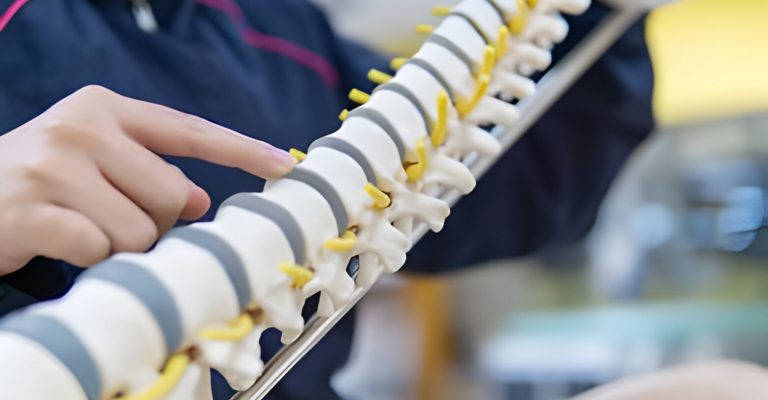Thoracic spinal cord damage results in one losing sensation and movement of parts of the whole body. In other words, control is lost over parts of the body such as the chest and legs, which we then term paraplegia.The effects of this injury may vary depending on how bad it is and where it’s located. This means that someone gets a little weaker, and moving around their legs becomes harder. But sadly, in severe cases, they might not be able to move or even feel anything from the waist down.
What is a Thoracic Spinal Cord Damage?
The Thoracic Spinal Cord is a collection of nerve tissue that runs right down the middle of your backbone. This wonderful biology helps our brain communicate with our body, sending messages back and forth. You can think of it as a telephone line with thirty-one pairs of ‘phone lines’ coming out between each bony part of your backbone.
Each nerve pair connects with different muscles to help us move. They also connect to different areas of our skin to help us feel things. In the middle part of our backbone, we have 12 pairs of these nerves. If these get hurt, we call it a T1-T12 spinal cord injury. The name depends on exactly where the injury happened.
These nerves in the middle part of our backbone help control the muscles in our trunk and inner arms.
Full vs. Partial Thoracic Spinal Cord Injury
The types of damage to the spinal cord are classified based on the extent to which the damage occurs—complete or incomplete. Complete spinal cord damage is like a highway with all lanes closed. It happens when all the pathways that connect your brain to your body are cut off at one point from injury.
The brain has lost its phone line to the body, where it had suffered an injury. It cannot send or receive messages back; hence, you can’t feel or move anything below the point where it took place.
On the other hand, an incomplete spinal cord injury is when some of the roads are closed while others remain open. Some messages could still go through between the brain and the body below the injury.
These still-active pathways could allow some feeling or movement signals to pass. This is why, at times, feelings and moving abilities that were assumed lost may reappear after an injury like this.

Causes of Thoracic Spinal Cord Damage
When discussing spinal cord injuries, we refer to the lowest part of the spinal cord, where all feeling and movement remain unchanged. For example, let’s say that someone has an injury called a T1 SCI. This means that all of the tasks managed by the T1 spinal nerves are working okay. However, all of the feelings and movements controlled by any of the spinal nerves below that level may not work like they used to.
T1, T2, T3, T4, and T5 Injury
Injuries to the T1-T5 section of your spinal cord primarily impact the muscles in your upper chest, back, and inside of your arms. This means that individuals with this level of injury may have some difficulty sitting up straight due to a somewhat diminished trunk or core stability.
The T1 nerve roots are important because they allow you to feel things in your inner forearm and spread your fingers wide. The T2 nerve roots, on the other hand, account for feelings around the armpits and upper chest areas and also aid in the movement of the muscles in the upper chest.
At different levels, the T3, T4, and T5 nerve roots also derive sensation to your upper back and chest. Thus, if a person injures his T4 spinal cord, he would express changes in sensation or movement from the middle of his chest downwards.
You have intercostal muscles between your ribs, which the T3-T5 nerve roots also affect. Those muscles could matter because they help you breathe—the chest grows larger and smaller during inspiration and expiration. Thus, breathing, sneezing, and coughing might get a bit tougher for someone at this level of injury.
Further, those with injuries or higher in the T6 level may suffer from a condition called autonomic dysreflexia. Autonomic dysreflexia is an operation that your body normally undertakes automatically, such as temperature control, heartbeat rate, blood pressure, and other related functions.
T6, T7, T8, T9, T10, T11, and T12 Injury
Injuries at the T6-T12 level generally affect sensation and movement rates in the belly and torso areas. However, this will not affect their arms and chest concerning control and sensation.
Generally speaking, T6 nerve roots are related to feeling surrounding the upper part of the belly. Hence, people who have a T6 spinal cord injury frequently see changes in sensation and movement from the upper abdominal down. Each subsequent group of nerve roots connects to a lower section of the thorax and abdomen.
Individuals or patients with less severe damage in the thoracic spinal region still tend to be able to hold up their torso, hence sit upright, move about without attendance, and perform many other tasks.
Thoracic Spinal Cord Damage Rehabilitation Process
Following a thoracic spinal cord injury, the process of rehabilitation becomes paramount to the recovery of lost abilities by a person and adjustment to new physical capabilities. These may include rehabilitation programs such as physical therapy, occupational therapy, speech therapy if needed, and mental health support.
Such physiotherapy may include exercises and activities to improve the affected body areas’ strength, flexibility, and coordination. Occupational therapy instructs patients regarding how to adapt routine daily tasks and activities to enable performance, given their disability. The impact on speaking ability, swallowing, or general communication after injury may result in a need for speech therapy.

Bottomline
It is also important, besides physical rehabilitation, to have mental health support after thoracic spinal cord damage. Emotionally, the process of coping with a life-changing injury is tough; having support is important.
Mental health professionals can help provide counseling and resources. This will aid in helping an individual cope emotionally with any changes and emerging adjustment problems.

